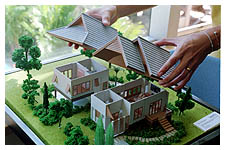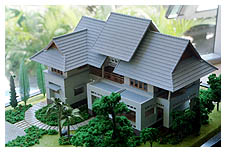Entrepreneur and Business Resources
Integral Methods and Technology
Governance and Investor Responsibility
|
Eco Building
Examples from teh Bangkok Post
No sweat to save energy
The National Energy Policy Office has recently released
blueprints of four energy-saving houses for the public. The designs are
well studied to help conserve not only the national energy but also save
money for the dwellers in the long run
Story By Karnjariya Sukrung, Pictures by YINGYONG UN-ANONGRAK
 |
| Open up your house for the energy-saving concept. Forget the air-conditioners. Managing natural surroundings will not only cool your house but also save money for you. |
Air-conditioners have become an integral part of comfortable modern life despite the high cost of the appliance and soaring electricity bills.
However, this modern cooling device is not the only solution to combat the heat. In fact, we might not need an air-conditioner at all, if we learn to manipulate the natural surroundings as revealed in project Baan Harn Song (Energy-saving house) jointly studied by Plan Co., Ltd and the Faculty of Engineering, Chulalongkorn University.
"The use of electricity in Thailand is increasing each year, with one-third of all electricity consumed in households. And as much as 74 percent of the power used in the household is spent on the cooling system," remarked Suthasinee Suntinanond, Plan Analyst of the National Energy Policy Office (Nepo). "Air-conditioners account for about 70 percent of electricity costs every month. It is the most expensive electrical appliance in the household," she added.
"Apparently, to conserve energy and save money, we must begin with ways to stop using air-conditioners in homes," she said.
The study project supported by Nepo has launched four blueprint designs of energy- saving houses since August 7.
The four designs include a one storey house for a family of two; a two storey-house with two bedrooms and two bathrooms; a two-storey house in 200 square wahs (800 square metres) with three bedrooms and two bathrooms; and the biggest design with three bedrooms and three bathrooms.
These designs are planned for small to medium-sized families and living in regional and suburban residential areas.
To build an energy-saving house, one needs three important things: a plot of 100-200 square wahs, (400 to 800 sq m) cash of about 800,000 to 1.8 million baht for home-construction, and a good understanding of energy-saving concepts.
As the energy-saving house relies on the cooling and heat-proofing systems of nature, the home requires adequate space to create a natural environment with enough trees and a pond.
The construction is estimated to cost up to 1.8 million baht and is calculated on basic, easy-to-find and affordable materials available in the market.
"The energy-saving home does not demand complicated technology or expensive materials as we want the houses to be easy-to-maintain and to repair," said Runglawan Itharat, managing director of Humanist Co.Ltd, an architectural, interior design and planning company.
"However, those who have more money can go for the optimum, the best quality of materials to enhance the energy-saving process," she added.
Although the cost of construction and land for energy-saving houses may not be attractively lower than other houses sold in the real estate market, lower costs on electricity bills over a long period may pay off and make it worth the investment.
"Our study compared two three-bedroom houses of the same size; one was an energy-saving house and the other a regular one. We found that the energy-saving house saved about 2,000 baht a month just by not using air-conditioners," said Runglawan.
Principles of the energy-saving house
Based on the ideologies of architectural design and energy-saving policies, the energy-saving houses do not need air-conditioners. The design strategies focus less on technology and more on nature manipulation-providing comfort by making use of nature to generate coolness and reduce heat in the house.
After a one-and-a-half years of study, Plan Architects and engineering researchers have produced suitable designs of modern, energy-saving homes. Interestingly, their four designs resemble the traditional Thai house-steep high roof, elevated floors, common space for family activities and large green areas.
"We found that traditional Thai houses are the best home designs for our region," said Nitisak Chobdamrongtham, the director of Plan Architect Co.Ltd.
 |
| One of the three designs of a cosy two-storey house. |
With these findings, the Nepo home designs thus embraces the same principles hidden in ancient architectural wisdom.
"Building energy-saving homes is not complicated and does not require high technology. On the contrary, we only need to have a basic knowledge of architecture and nature; for example, the right position and zoning of the house, sun-control methods, wind current manipulation and construction materials," said Nitisak.
Primarily, a hot or cool house can be judged by the direction it faces and position it is in.
"If the front, or the widest part of the house is facing east or west, it is inevitably hot. The house receives sunlight all through the day until sunset," said Nitisak.
"The best direction for the house to face is either north or south. North is better, though," he suggested.
Facing north or south will help reduce sunlight coming into the house. Moreover, the north and south are usually windy.
To ensure good ventilation, the house must be built at some distance from other houses or constructions. Inside the house, each room and space should be well-planned. The energy-saving houses are designed to be airy with more open and common areas.
"Zoning the functions of the room is also important. To design a home, we have to keep in mind the way of life of the residents, so we can arrange the floor plan to suit their needs, along with the primary aim of energy-saving," said Nitisak.
Each room should be set apart in order to increase ventilation. Closely-built rooms hamper ventilation. Each room should have enough windows to keep it airy.
A well-planned structure can also control the sun's impact in the house.
Like a traditional Thai house, the roof should be steep, preferably leaning over 60 degrees to reflect the heat out.
Installing overhangs or awnings at the windows also helps to reduce glare and heat.
Colours, especially light hues, help greatly in reflecting the sun's rays out of the house. According to a study by Nepo, white reflects up to 90 percent of light and heat while brown reflects only 15 percent.
The materials used in the structure of the house also need careful selection. According to Nitisak, wood is be a good material for building homes in this tropical region. It reflects heat and sunlight fast. Concrete however absorbs heat and releases it slowly. Insulating materials are highly recommended to keep heat out.
But the most important factor in generating coolness is trees.
"Trees absorb light and heat and are the best natural air-conditioners. The more trees, the cooler the house will be," said Nitisak.
According to Nepo, the amount of heat energy required for one litre of water to evaporate from a tree is about 2,200 BTU (British Thermal Units). If there are enough trees to evaporate 65 litres of water, the trees can cool the area as much as a one-tonne air-conditioner.
"Big trees grown along the east and west sides of the house will naturally cast their shadows on the house all day," said Nitisak.
But, not every tree can be used for this air cooling purpose. Deciduous trees (those which shed their leaves annually) cannot be used and trees with expanding roots may damage the foundations of the house.
Big trees should not be grown at the northern or southern sides of the house as they will block the passage of the wind. Instead, shrubs, hedges and small plants can be planted to cool the wind.
Moreover, trees serve as a natural barricade for noise and also filter dust.
Ultimately, to run a truly energy-efficient home, electrical appliances should be energy-saving, and rated number five. It's prudent to avoid having superfluous electrical appliances at home.
"It is fine if people modify our designs to suit their own lives as long as they understand the concept and do not alter the plans in a way that disrupts the energy-saving concept; otherwise, it will no longer be a cool house," said Suthasinee.
So far, more than 3,000 people have asked for the house plans. Some land developers have also acquired the house designs from Nepo.
"We sell the designs at a very low price as we would like to make them affordable for the public. We would like to create an awareness among the public, architects and engineers that energy-saving can be largely done at home. Not all people will build their homes strictly based on our designs. But we believe they will buy the idea of an energy-saving home, and that is our ultimate goal," said Suthasinee.
Note:
More details on energy-saving houses and ways to modify your home to be energy-efficient can be found on the Web site of the National Energy Policy Office at www.nepo.go.th.
Those wishing to acquire construction plans and the manual of construction, can buy them from Nepo's office. The cost ranges from 35 to 70 baht for each home design while the manual is priced at 20 baht.
Nepo also has several brochures detailing ways to conserve energy at home.
The Energy Saving House Consultation Centre is underway. Nepo can be reached on 612-1555 ext 201-5 or fax 612-1368.
Tips for city and old home residents
The energy-saving home designs are aimed at those living in suburban or regional areas where pollution is minimal. However, it does not mean that those who already have a house or are living in the city cannot apply to have a energy-saving house.
"Naturally, heat and pollution tend to rise up to higher ground. There are still some ways for city dwellers to manage their homes, make use of natural environment and cut down their electricity bills," said Nitisak Chobdamrongtham, the director of Plan Architect Co.Ltd.
Here are some useful tips for city and old home residents:
- Plant trees or shrubs along the east and west sides of the house to provide shade and to act as a buffer against dust and noise.
- Rearrange furniture. Remove furniture that obstructs the flow of the wind into the room.
- Paint the house in light colours, both interior and exterior. The roof also should be in a light hue like white, beige, or cream.
- Use ceramic and marble on the ground floor to help absorb coolness from the earth into the house. The upper floor should be wood.
- The windows and doors should be open to create air flow. Clean windows and door nets often.
- Car parking should not be near the home in order to avoid pollution and most importantly, so the garage building does not obstruct wind flow. The garage should be an arbour.
- If your roof is not steep with more than 60 degrees leaning angle, building roof vents can help release heat accumulated under the roof.
- Ensure windows are well shaded by external overhangs, blinds or awnings.
- Clean air-conditioners and fans regularly.
- Avoid using electrical appliances in air-conditioned rooms, as they generate heat.
- Open windows and ventilate the house when it is cooler outside than inside.
- On a hot day, close all blinds, curtains, windows and doors to keep out the heat.
- Do jobs such as cooking, washing and ironing at the coolest time of the day.